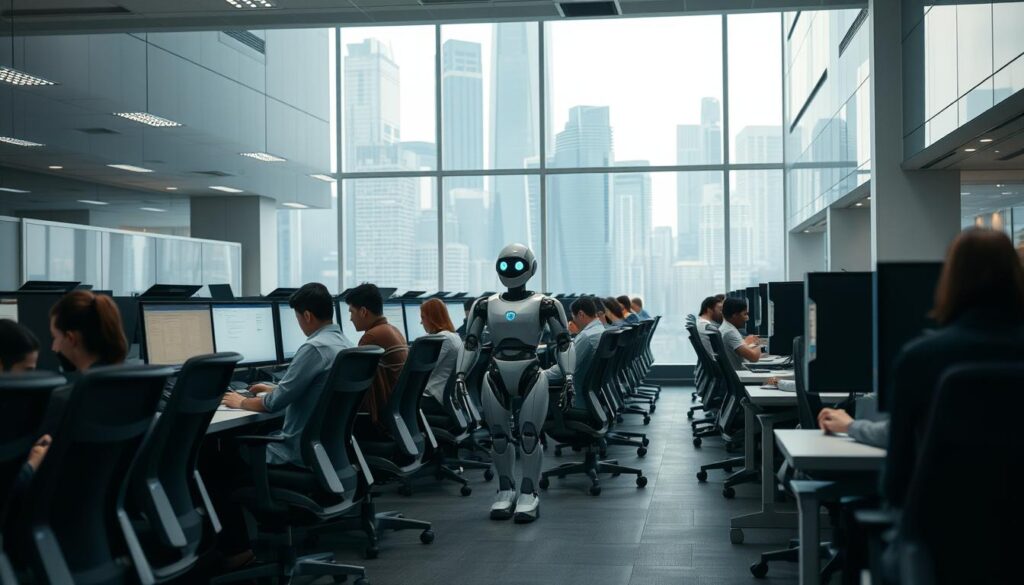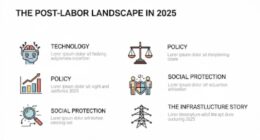Did you know that it’s estimated that up to 47% of jobs in the United States could be automated within the next two decades? As artificial intelligence (AI) rapidly progresses, the concept of a ‘white-collar bloodbath’ has emerged, raising alarm bells across various industries. Dario Amodei, CEO of Anthropic, highlights the potential for significant job losses in entry-level positions as AI job automation continues to rise. With such staggering job predictions, the employment impact is bound to be profound, altering the fabric of today’s workforce and reshaping how we approach careers.
Key Takeaways
- 47% of jobs in the US may be at risk of automation by 2040.
- The term ‘white-collar bloodbath’ refers to massive job losses in professional sectors.
- Dario Amodei warns that AI could significantly affect entry-level jobs.
- AI job automation is becoming a central topic in employment discussions.
- The impact on careers and industries will require proactive adaptation.
The Rising Concern of Job Automation
As technology rapidly progresses, job automation has become a pressing concern. Defined as the use of technology to execute tasks traditionally carried out by human workers, job automation influences various sectors. The introduction of advanced automation technology, particularly with AI capabilities, is reshaping the employment landscape. Many individuals, especially those in entry-level positions, are now questioning the stability of their jobs.
What is Job Automation?
Job automation refers to the integration of technologies that enable machines to perform tasks that humans once undertook. This shift has broad implications for the workforce and economy. With AI becoming increasingly capable of managing complex tasks, the fear of job loss looms large among workers. As tasks become automated, understanding the nuances of this trend is essential for navigating the changing job market.
Statistics on Job Loss Predictions
Job loss statistics indicate a troubling future for many employment sectors. Current predictions suggest that up to 50% of entry-level white-collar jobs may disappear within the next five years. Reports indicate potential unemployment spikes of 10-20% in various industries, prompting concern about the AI employment impact. The statistics illustrate not just a possibility but a looming reality that many individuals will face as automation technology becomes more prevalent in workplaces across America.

The ‘White-Collar Bloodbath’ is all part of the AI hype machine
The term ‘white-collar bloodbath’ has emerged in discussions surrounding the transformative effect of artificial intelligence. This phrase encapsulates fears of widespread job losses in sectors traditionally seen as secure. As AI continues to evolve, the predicted mass unemployment raises eyebrows among industry experts and the public alike.
Defining the Term ‘White-Collar Bloodbath’
The ‘white-collar bloodbath’ refers to significant layoffs and unemployment affecting highly skilled jobs due to automation. Unlike past industrial revolutions, the current wave of AI innovations is reshaping roles in finance, healthcare, law, and other sectors. Workers previously considered insulated from job displacement now face uncertainty as companies seek efficiency and cost savings through advanced technologies.
Expert Opinions on the Impact of AI
Industry expert opinions shed light on the future workforce landscape. Dario Amodei emphasizes the importance of transparency about the AI impact on employment, advising developers to communicate potential job displacement clearer. Many professionals believe that existing job predictions may significantly underestimate the extent of AI’s disruption. Experts argue for proactive measures, advocating for a prepared workforce ready to adapt to shifting market demands.

Current Trends in Employment Among Recent Graduates
The job market for recent graduates remains a pressing concern as graduate unemployment statistics reveal an alarming trend. A significant rise of 30% in unemployment among college graduates since 2022 has brought current rates to 5.8%. As you delve into these statistics, it’s worth noting that even graduates from prestigious institutions like Harvard and Wharton are facing challenges in securing job placements. This situation reflects broader job market trends that show a tightening landscape, making it increasingly difficult for even the most skilled candidates to find suitable employment.

The challenges faced by recent graduates vary by industry, presenting significant hurdles in areas such as tech, finance, and consulting. These industries, once considered robust employment sectors, now present a complicated landscape with rising competition and limited openings. As automation and AI continue to reshape job roles, you may find that securing a position requires more than just a degree. Anticipating and adapting to these challenges for recent graduates will be crucial for those entering the workforce today.
Reflecting on these trends can motivate you to enhance your skill set and remain adaptable in an uncertain job environment.
The need for continual learning and networking has never been more critical. By understanding the current climate, you can better position yourself to navigate these evolving challenges in pursuit of your career aspirations.
The Role of AI in Shaping the Workforce
The advent of advanced technologies brings profound changes to the workplace, altering how work is accomplished and highlighting the remarkable AI capabilities that emerge. As organizations incorporate AI into their operations, the workforce experiences significant transformations. The growing presence of AI in the workforce calls for a serious evaluation of roles and responsibilities across various sectors.
Understanding AI’s Capabilities
Today’s AI systems exhibit extraordinary capabilities, allowing them to perform tasks that were once thought to be exclusive to human professionals. From analyzing data to automating routine tasks, AI now executes processes swiftly and accurately. This evolution, seen in platforms like Anthropic’s Claude, showcases how automation technologies are set to redefine job functions, potentially displacing traditional labor roles while enhancing productivity.
The Shift Toward AI-First Companies
A notable trend in the corporate landscape is the emergence of AI-first companies, which prioritize artificial intelligence solutions over human input. Businesses like Shopify and Duolingo illustrate this shift, investing heavily in automation strategies that improve efficiency and reduce costs. These changes lead to increased expectations on employees to adapt, acquire new skills, and find innovative ways to coexist with the machines that are now pivotal to day-to-day operations.

| Company | Industry | AI Implementation | Impact on Workforce |
|---|---|---|---|
| Shopify | E-commerce | AI-driven customer service | Reduced customer support roles |
| Duolingo | Education | Personalized learning algorithms | Enhanced tutor efficacy; shift in teaching roles |
| Amazon | Retail | Automated warehouse operations | Job displacement in manual handling |
As AI capabilities expand, the conversation around automation’s role in reshaping job landscapes becomes increasingly crucial. The transition toward AI-first companies embodies a strategic move driven by the need for innovative solutions and enhanced productivity. Understanding these dynamics will help you navigate this transforming workforce effectively.
AI Predictions: What Experts Are Saying
The discourse surrounding the employment future often includes stark warnings from leaders in the field, including Dario Amodei, who predict significant job loss due to the advancement of artificial intelligence. Amodei’s insights paint a troubling picture, suggesting that many sectors may face major disruptions as automation technology continues to evolve. Such expert predictions raise the question of whether the workforce is prepared for these immense changes.
Dario Amodei’s Realities of Job Loss
According to Dario Amodei, the CEO of Anthropic, we may be on the verge of an era where job loss becomes a common reality. The fear is that as AI technology becomes more capable, many traditional roles could become obsolete. This perspective highlights a critical concern for employees across various industries, as the threat of job displacement looms large.
Counterarguments on the Future of Employment
Contrasting these dire expert predictions, some voices in the industry argue that historical instances of technological advancement have ultimately led to job creation rather than a net loss. New technology has repeatedly displaced jobs while simultaneously generating new roles that often demand different skill sets. This dynamic suggests that instead of solely focusing on the impending job loss, it is essential to consider how adaptation and reskilling can shape a resilient employment future.

The Future Job Market: Preparing for Change
As the future job market evolves under the influence of artificial intelligence, young professionals must cultivate a diverse set of skills to maintain relevance. The landscape of employment will demand adaptability, fostering creativity, and enhancing digital literacy. Embracing these attributes will become essential for standing out in a competitive atmosphere.
Skills Young Professionals Will Need
To thrive in this rapidly changing environment, specific skills needed will come to the forefront:
- Data analysis and interpretation
- Proficiency in AI and machine learning tools
- Effective communication and collaboration skills
- Problem-solving and critical thinking abilities
- Emotional intelligence and empathy
Strategies for Career Resilience
Implementing effective career resilience strategies is crucial for adapting to the demands of the modern workforce. Consider these actionable steps:
- Engage in continuous learning through online courses or certifications.
- Network actively within your industry to remain informed about trends.
- Seek mentorship from professionals who have successfully navigated career changes.
- Explore interdisciplinary fields that blend different areas of expertise.
- Become proficient in digital tools and software relevant to your industry.

The Ethical Implications of AI-Driven Job Loss
The rapid advancements in artificial intelligence technology bring numerous benefits, yet they also pose significant ethical implications of AI, particularly concerning job loss. As automation continues to reshape the workforce, certain demographics face more considerable risks of displacement than others. Understanding these nuances is crucial in fostering a future that prioritizes equity.
Disparities in Job Loss Among Demographics
Research indicates that job loss demographics are not distributed evenly across society. For instance, women often occupy roles in customer service or administrative positions that are highly susceptible to automation. Such patterns raise vital questions about fairness and equality in AI-induced job displacement. Companies and communities must recognize these disparities and consider the human impact behind their technological transitions.
The Role of Policy in AI Regulations
Effective AI policy regulations are essential to address these challenges. Policymakers play a critical role in creating frameworks that ensure equitable treatment of affected workers. Implementing transition programs, supporting re-skilling initiatives, and promoting ethical AI development can assist in mitigating the adverse effects of job automation. Through thoughtful regulation, society can work toward reducing the negative consequences linked to job loss while maximizing the benefits AI offers.

Historical Context: Technology and Job Creation
When exploring the interplay between technological advancements and job opportunities, examining the historical context provides valuable insights. Past revolutions have shown that while technology can disrupt current employment landscapes, it often paves the way for new roles that society hadn’t previously envisioned. Understanding these dynamics may help you navigate the uncertainties of today’s economy.
Past Technological Revolutions
Each significant technological shift has transformed industries and redefined roles. For example:
- The Industrial Revolution: This period transitioned work from manual labor to machine-driven processes. While many traditional jobs vanished, a host of new manufacturing roles emerged.
- The Computer Age: The rise of computers and digital technology displaced some clerical jobs but created entirely new sectors, such as IT and software development.
- The Internet Revolution: It not only disrupted retail and media but also led to the birth of e-commerce, social media, and a need for digital marketing professionals.
Predicted Outcomes Based on Historical Data
Recognizing trends from historical context underscores the possibilities of future job transformations. Recent analyses have indicated that:
- Technology and employment are likely to evolve hand-in-hand, similar to past transitions.
- New industries will continue to emerge, focusing on sustainability, artificial intelligence, and renewable energy.
- Flexibility in job roles may rise, with a growing emphasis on adaptability to new tools and processes.

Conclusion
The ongoing conversation surrounding the ‘white-collar bloodbath’ serves as a crucial reminder of the uncertainties you face in the job market, influenced heavily by advancements in artificial intelligence. As we examine the AI job impact, it’s clear that these changes are not mere speculation; they represent tangible shifts that affect white-collar jobs across various industries. This tumultuous landscape necessitates an awareness of how AI is reshaping not just the workforce but the very expectations tied to employment futures.
To navigate these complex challenges, you must engage proactively with all stakeholders—be it educators, legislators, industry leaders, or fellow professionals. By fostering an adaptive workforce, you can better prepare for the implications that AI advancements bring. It’s about more than just keeping up; it’s about positioning yourself and your community to thrive amidst these changes.
Ultimately, understanding the nuances of AI’s impact is essential in developing strategies that promote resilience and adaptability. Embracing this approach will allow you to seize opportunities that arise in the evolving job market and ensure that you remain competitive in a world where AI plays an increasingly pivotal role in shaping employment futures.









